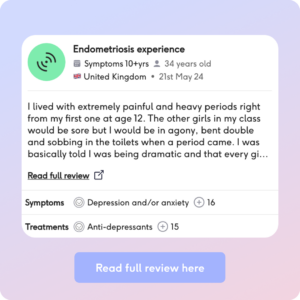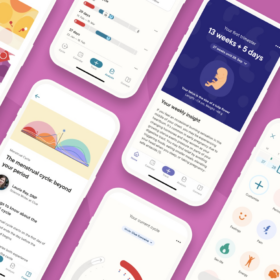
What is Adenomyosis?
In this article
What's the lowdown?
Adenomyosis is a condition affecting the muscular layer of the uterus (womb)
In this condition endometrial tissue (lining of the womb) invades this muscular layer, growing and shedding like our uterine lining
It can lead to heavy and painful periods
Treatments range from pain relief, hormonal contraception, non-hormonal medications or surgery
What is adenomyosis?
Adenomyosis or ad-uh-no-my-O-sis!
Oh sis, another condition that affects the female productive system? We’ve got endometriosis, polycystic ovarian syndrome, fibroids, ovarian cysts….. now what?
Adenomyosis is a condition that affects the uterus (also known as womb). Let’s recap the anatomy of the uterus before we get medical.
The uterus has 3 layers:
- The innermost layer: Endometrial lining
- Middle muscle layer: Myometrium
- Outermost protective layer: Perimetrium
So now we know the uterus a little better, adenomyosis is defined as a condition where the endometrial tissue grows into the muscular layers of the uterus.1
Our endometrial lining is a special type of tissue. It can respond to our changing hormones. It grows preparing for pregnancy and sheds when a fertilised egg is not implanted, leading to your period. And the endometrial tissue in the muscular layer responds no differently. It will grow and shed, without enough space for the blood to escape.
What causes adenomyosis
Sadly, the medical jury is still out. I can hear you asking, why is there so much still not known about women’s health. I agree more research needs to be done, and we’re advocating for that!
The government announced that it is investing £25 million2 into expanding women’s health hub services and research, so it is a step in the right direction. We are worth it!
There are some theories on the factors that might increase your risk3:
- Age: women and those assigned female at birth have usually developed adenomyosis later in their childbearing years, often between the ages 35-50
- Childbirth: Delivering more than one baby has been linked to adenomyosis as it has been suggested that endometrial tissue is more likely to invade the muscular layer during implantation of the pregnancy. But it’s just a theory.
- Surgical procedures: Studies that are looking into adenomyosis have found trauma to the uterus in the form of surgeries like caesarean deliveries and dilatation and curettage (a treatment for abortion and miscarriage and other gynaecological conditions). These surgical procedures could increase the chances of adenomyosis and is a known risk factor of developing the condition due to more research about this link.
Adenomyosis symptoms
Adenomyosis is not as common as other gynaecological conditions.
33% of people assigned females at birth (AFAB) do not experience any symptoms from adenomyosis and might only get diagnosed by chance.4
But if you fall in the remaining 67%, you might experience the effects of adenomyosis such as:
- Heavy periods (menorrhagia)
- Painful periods (dysmenorrhea)
- Pain in the back/pelvic area
- Pain during or after sex (dyspareunia)
- A bulky (enlarged) uterus
- Bloating (sometimes referred to as adenomyosis belly)
These symptoms might sound similar to you. Yes, the symptoms are general and can overlap with other conditions like endometriosis but more on that later.
How do I get an adenomyosis diagnosis?
As this diagnosis is still not fully understood, there is no gold standard investigation for adenomyosis. There might be a few different tests your doctor or specialist might suggest. Your doctor might initially suspect adenomyosis based on the symptoms you complain about and any risk factors that might increase your chances of the disease.
This might then trigger your doctor to do a5:
- Pelvic exam: your doctor will have a look at your external genitalia and then feel inside your vagina to assess your cervix and uterus to identify if it is large and bulky. As this is an intimate examination, you can ask for a female doctor and a chaperone to feel more at ease
- Ultrasound: Ultrasound scans are not very accurate at identifying endometrial tissue but they can produce an image of the overall uterus and help us identify how thick the muscular layer of the uterus is. It can also rule out other conditions which could be causing your symptoms, like fibroids
- Magnetic Resonance Imaging (MRI) scan: This scan better shows any enlargement or thickening of the uterus compared to an ultrasound
- Hysteroscopy: Viewing the uterus with a small camera through the cervix directly into the vagina. A biopsy of the uterine endometrial tissue (collecting and testing some cells from the womb lining) might also be taken simultaneously to rule out other conditions like overgrowth of the womb lining or rarely, uterine cancer
Unfortunately, the only way to get a true diagnosis of adenomyosis is by looking at the uterus under a microscope after a hysterectomy (removal of the uterus), but this might not be a viable option for those of you who want children. An ultrasound and MRI can still aid in the diagnosis of the condition.
Adenomyosis vs endometriosis
Both adenomyosis and endometriosis involve endometrial-like tissue. And yes they both present similarly, with painful heavy periods. But adenomyosis tends to cause heavier bleeding. The main difference is where the tissue grows. Endometrial-like tissue grows into the muscle of the uterus in adenomyosis while in endometriosis, the endometrial-like tissue grows outside the uterus6.
A study found a high association between endometriosis and adenomyosis, finding a link in 54-90% of cases7.

Feel like you can relate, so why not share your experience too.
Adenomyosis treatment
Sadly there is no way to permanently remove the endometrial tissue in the muscle layer of the uterus other than a hysterectomy (removal of the womb). But there are treatments to alleviate the symptoms that come with the condition.
Pain medications
Ibuprofen or stronger non-steroidal anti-inflammatory medications like naproxen can be given to you to soothe the cramping and pelvic/back pain.
Hormonal medication
Generally, the use of contraceptives is recommended in adenomyosis to tackle the pain and heavy bleeding. Birth control pills, the progestogen injection, or the hormonal coil (IUD) can be used. With the hormonal IUD, there are multiple types with varying strengths but to see benefit, we would recommend going for the highest dose of progestogen, as these are licensed to treat heavy bleeding. These are the Mirena, Levosert, or Benilexa, or also the Liletta in the US.
Non-hormonal medication
If contraception is not an option for you right now, or you aren’t comfortable with having more hormones due to side effects, you can ask for something else like tranexamic acid. This type of medication aims to reduce menstrual bleeding.
Hysterectomy
This option is not generally recommended if you are of childbearing age. A hysterectomy completely removes your uterus from the body. While it is a definitive way to resolve your symptoms, it is also a definitive way of not being able to have children. It is usually reserved as the final option or for women and AFABs having completed their family or reached menopause.
Adenomyomectomy
A conservative option for women and AFABs looking to preserve their uterus. Adenomyomectomy is another surgical procedure but instead of removing the uterus, it aims to remove the abnormal tissue in the uterus wall. A study has shown that this novel technique can reduce 65% of heavy bleeding and 41% of painful periods8.
This treatment option is fairly new and may not be readily offered by all healthcare centres. It also may depend on where in the uterus you have adenomyosis. However, it’s a promising surgical technique for those who wish to have children in the future but need to control their symptoms.9
Endometrial Ablation
To reduce heavy bleeding, endometrial ablation removes the endometrial lining of the uterus permanently using heat, cold, or radiofrequency. As the lining is no longer there, your periods should lighten and become more manageable. But as there is no more lining, pregnancy is not possible in the future so is not recommended for women of childbearing age. This option only alleviates the heavy bleeding, not the pain associated with adenomyosis.
Uterine artery embolism
Uterine artery embolism is a procedure that block the arteries which supply the uterus. By blocking the blood supply to the endometrial lining of the uterus, your periods will become lighter as a result. This treatment might also help reduce the discomfort of adenomyosis, with 83% of people having relief from their symptoms. It is not guaranteed that you can get pregnant after this procedure, but one review found pregnancy rates of almost 40% following uterine artery embolisation10.
Complications of adenomyosis
Heavy menstrual bleeding is the main symptom commonly associated with the condition. With the high amount of blood loss, sometimes you can develop iron deficiency anaemia as a complication. This is where you have fewer red blood cells than normal due to losing so many during a heavy period, and not having enough iron needed to quickly replace the blood cells. While not life-threatening, it can have a significant impact on your life such as tiredness, shortness of breath, increased heart rate, dizziness, and paleness.
Chronic pain if not treated is another complication. If not addressed, this continual pain can affect your quality of life and physical and mental health. That is no way to live!
Adenomyosis after menopause
You’ll be relieved to hear that adenomyosis gets better after menopause and in most cases completely resolves. As our hormones are declining and no longer taking us on a monthly roller coaster ride, the endometrial-like tissue does not respond to oestrogen like it normally would. So no more heavy, painful periods.
A rare case of adenomyosis was reported in a 68-year-old Indian woman who was struggling with heavy post-menopausal bleeding despite having reached menopause at the age of 52.11
Adenomyosis and fertility
The extent to which adenomyosis affects fertility rates still needs to be established with further research. One theory on how the condition affects fertility is due to the lack of adequate functioning of the uterus affecting the implantation of the egg on the uterus wall.12 It seems that adenomyosis can affect women getting pregnant, and may affect the success of fertility treatments such as IVF.13 A study in 2014 found that IVF success rates in women with adenomyosis are 28% less than in those without the condition while the rates of miscarriage and stillbirth are higher. However, there’s still lots of gaps in knowledge in this area, and every researcher states in their studies that more work is needed to understand fully how adenomyosis impacts fertility and how it can be improved.
Adenomyosis and pregnancy
Women with adenomyosis can and do get pregnant and have children. However, adenomyosis has been associated with negative pregnancy outcomes. Studies have found higher rates of miscarriage and preterm birth14, along with pre-eclampsia, malposition of the placenta, and small-sized infants15. However, this does not mean that adenomyosis sufferers cannot have successful live pregnancies.
During a pregnancy, you don’t have periods so the main symptoms of adenomyosis (heavy painful periods) will tend to improve. There isn’t much research about what other symptoms you may get from adenomyosis during pregnancy. We know that the appearance of adenomyosis on scans changes due to the pregnancy hormones, but don’t have any further information on how that could impact your symptoms.16
More questions?
Adenomyosis is a complex gynaecological condition that we need more research into. We covered multiple aspects of the condition today in detail. It might be a lot to take in but you don’t have to make any decisions for yourself. Now you know the condition a little better, speak to one of our GPs, who specialise in women’s health. We can answer any questions you might still have and advise you on what might be causing your symptoms.
Our medical review process
This article has been medically reviewed for factual and up to date information by a Lowdown doctor.






